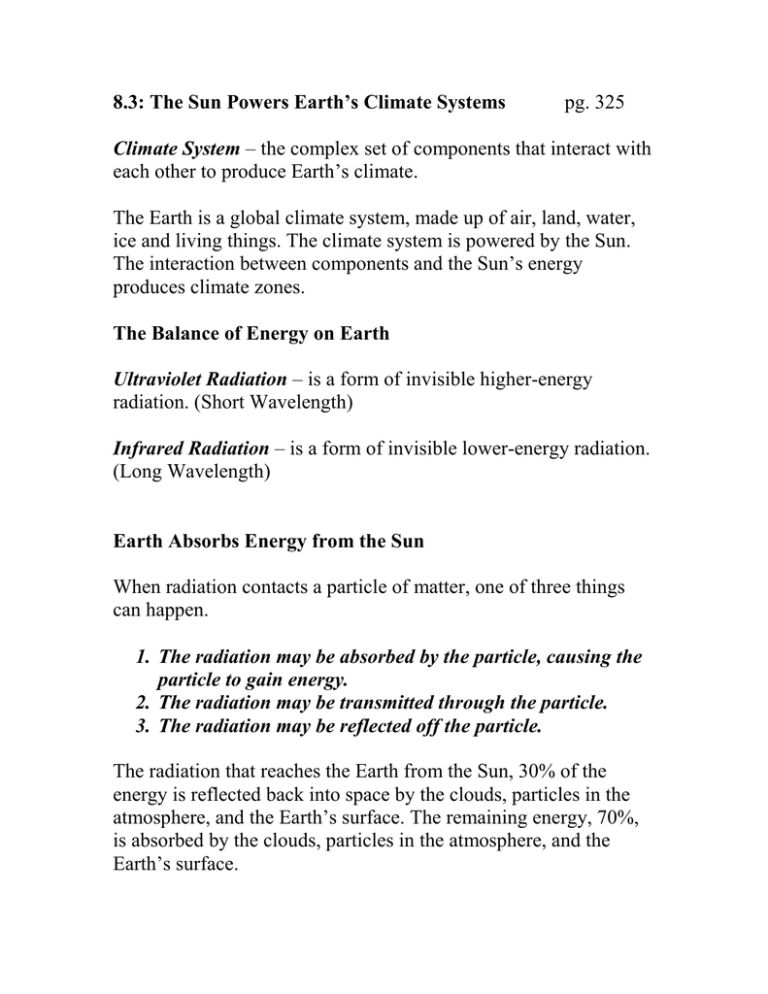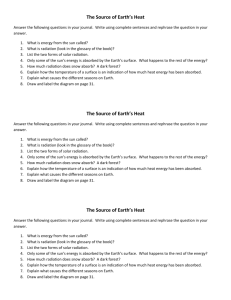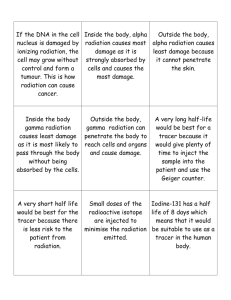8.3: The Sun Powers Earth’s Climate Systems pg. 325
advertisement

8.3: The Sun Powers Earth’s Climate Systems pg. 325 Climate System – the complex set of components that interact with each other to produce Earth’s climate. The Earth is a global climate system, made up of air, land, water, ice and living things. The climate system is powered by the Sun. The interaction between components and the Sun’s energy produces climate zones. The Balance of Energy on Earth Ultraviolet Radiation – is a form of invisible higher-energy radiation. (Short Wavelength) Infrared Radiation – is a form of invisible lower-energy radiation. (Long Wavelength) Earth Absorbs Energy from the Sun When radiation contacts a particle of matter, one of three things can happen. 1. The radiation may be absorbed by the particle, causing the particle to gain energy. 2. The radiation may be transmitted through the particle. 3. The radiation may be reflected off the particle. The radiation that reaches the Earth from the Sun, 30% of the energy is reflected back into space by the clouds, particles in the atmosphere, and the Earth’s surface. The remaining energy, 70%, is absorbed by the clouds, particles in the atmosphere, and the Earth’s surface. Figure 3: Incoming energy from the sun is reflected (30%) and absorbed (70%) by Earth’s surface, clouds, and the atmosphere. Plants will use only 1% of the Sun’s energy for photosynthesis. The rest warms the earth’s surface, (rocks and water), which in turn warms the surrounding air. How Does Earth Maintain a Balance? The Earth continuously absorbs energy from the Sun, yet the Earth’s temperature remains relatively constant. Earth’s Surface Emits Energy Energy can be converted from one form to another. The energy that is absorbed from the Sun causes the Earth’s surface to increase in temperature (Thermal Energy). Thermal Energy – the energy present in the motion of particles at a particular temperature. The Earth emits mostly lower-energy infrared radiation back into the atmosphere. The amount of energy radiated by the Earth’s systems is equal to the amount of energy absorbed from the Sun. This results in a constant global temperature. Figure 5: The energy absorbed by Earth (yellow arrows) is equal to the energy radiated by Earth (red arrows). As a result of this balance of energy, Earth’s global temperature stays fairly constant. Latitude and Climate Zones The climate is warmer in the lower latitudes (Equator) and colder in the higher latitudes (North and South Poles). The climate is colder in the higher latitudes because the Sun shines directly overhead of the equator and less overt the poles. Therefore the sunlight energy is more intense near the equator, covering a small area, then at the poles a larger area. The climate also changes because of the tilt of the axis of Earth. Because of the tilt, sunlight must pass through more atmospheric particles before it strikes the Earth’s surface at the higher latitudes, therefore more energy is either absorbed or reflected back into space. Figure 7: (a) The energy from the Sun is more intense near Earth’s equator since it hits Earth’s surface directly. (b) Energy from the Sun is less intense near the poles since energy hits Earth’s surface at an angle and spreads over a larger area. Check Your Learning, questions 1 – 6, pg. 329






